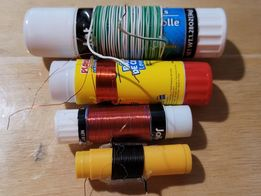A few weeks ago Pete Juliano and I got some e-mails from Paul Clark about his use of Chap Sticks and Glue Sticks (acquired at a Dollar Store!) in Permeability Tuned Oscillators.
Dean KK4DAS, Mike KA4CDN and I had been experimenting with PTOs following Farhan's use of one in his new Daylight Again transceiver. We are also looking at simple circuits for use in Direct Conversion Receiver builds for high school students.
Yesterday, I noticed a Glue Stick on the floor under my bench. TRGHS. I built one of Paul Clark's PTOs and used it with the circuit from Farhan's Daylight Again rig. For the ferrous material, I just glued (!) a .5 inch toroid (I think it is #7 material) onto the moving internal part of the glue stick. For the coil I used a total of 9 turns of #20 wire, with a tap at 2 turns. You can see the results in this video.
I think it is really useful, a very nice way to get good frequency control using an item available in most super-markets (I bought two glue sticks at Harris Teeter yesterday!). This continues a long ham radio tradition of using household items for ham projects -- we started with breadboards.
Some of Paul's coils:
Some of Paul's data:
Here's the data I got in testing these on the NanoVNA:
Dollar Store PTO Forms in 3 sizes
Small Jot Glue Stick (8 for $1.25!)
1 3/8" of #30 enameled close wound
waiting brass tubing to fit cup
80pf
2.980mhz with no core, I'm waiting brass tubing to fit this one (we have no hobby stores around here anymore that stock the K&S music wire and brass tubing assortments)
35.65uh
Medium Playschool Glue Stick
36t #30 enameled
1/2" copper water tubing
80pf
2.96m-3.380m
36.13uh-27.72uh
Large JOT Glue Stick
1/2" copper water tubing
80pf
28t #24 insulated
4.995m-5.625m
12.69uh-10.00uh

Bill,
ReplyDeleteHow's the 'slop factor' in the tuning? When you reverse tuning direction, is there a dead zone before the core starts moving again? If I recall, we used to call this 'backlash. Is there any tendency to jump as the shining mechanism binds up and releases?
put a light spring under the cup before installing it which will remove any backlash, or just mount the tube vertically and let gravity do it
DeleteNot 'shining, sliding.
ReplyDeleteI was just listening to the oscillator on a general coverage receiver. No signs of backlash. 73 Bill
ReplyDeleteI spoke too soon on the "slop factor." It is definitely there. A spring may help. 73 Bill
DeleteHe forgot the nose sniffers of eucalyptus oil for stuffy noses. My coil former!
ReplyDeleteLipstick come in tubes with the same mechanism.
ReplyDeleteI keep my color handy.
Its great that people recognize a resource!
Keep the ideas comming.
Allison
Great to hear from you Allison! 73 Bill
DeleteDeodorant sticks too
ReplyDeletefor backlash you can put a light spring over the screw before installing the cup that preloads the cup out eliminating backlash
ReplyDeleteThe spring idea is a really good one. I do notice some "looseness" in the tuning, especially when I change directions from up to down or vice versa. I think this is because the cup is riding kind of loose on the screw. A spring would help. Thanks and 73 Bill
ReplyDeleteThis is another perennial challenge in building high quality tunable oscillators. A good example of similar solutions to the problem can be found in the old WWII ARC-5 radio master VFO. It used a worm gear setup with the driven gear actually being 2 parallel gears with a spring between them to keep the driving gear 'loaded with mechanical tension. That, combined with a high quality polished worm drive gear and lots of grease, made for silky smooth tuning with virtually no gear lash.. I suspect another problem with these 'lipstick tube drives will be jumping when trying to make fine frequency adjustments because the plastic threads are somewhat coarse. But, hey, we're hams. We can do wonders with sows ears.
ReplyDeleteJoe
Yea, you see those spring loaded anti-backlash gears all the time. They are in the Yaesu FT-101 VFO, the Galaxy 5, several Hallicrafters transmitters, and in many other rigs. 73 Bill
DeleteHi, can you please share the schematic?
ReplyDeleteI have what's probably an overly simple question. In Farhan's design, is there a permeable material in the coil that is moved by the brass screw? Brass has a permeability of zero, so it doesn't seem like it should affect the inductance of the coil. Apologies if I just missed something here or in Farhan's writeup.
ReplyDeleteHamilton: You are right about the bronze. But what happens here is that as you screw in the bronze, eddy currents in the bronze act as if they were shorted turns in a secondary. This too changes the inductance. So these are really variable inductance oscillators. You can use steel screws, but with these you will get a combination of the permeability effect and the eddy current effect. 73 Bill
ReplyDeleteThanks Bill! It occurred to me late last night (honest :) ) eddy currents!!! It's a lot of fun getting to work with all this stuff again. Thanks for the great blog!
DeleteThanks Bill! It occurred to me late last night (honest :) ) eddy currents!!! It's a lot of fun getting to work with all of this stuff again. Thanks for the great blog!
Delete